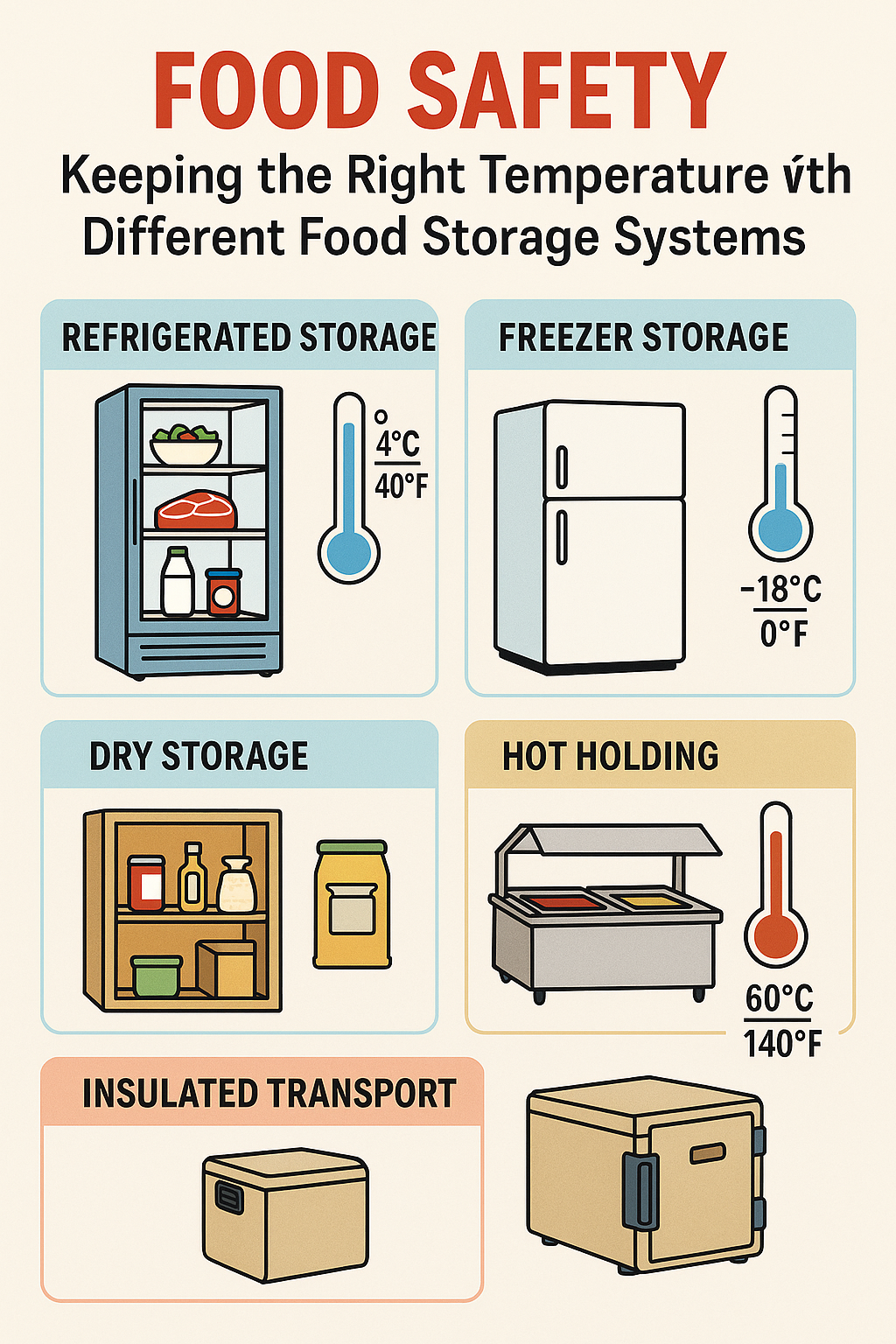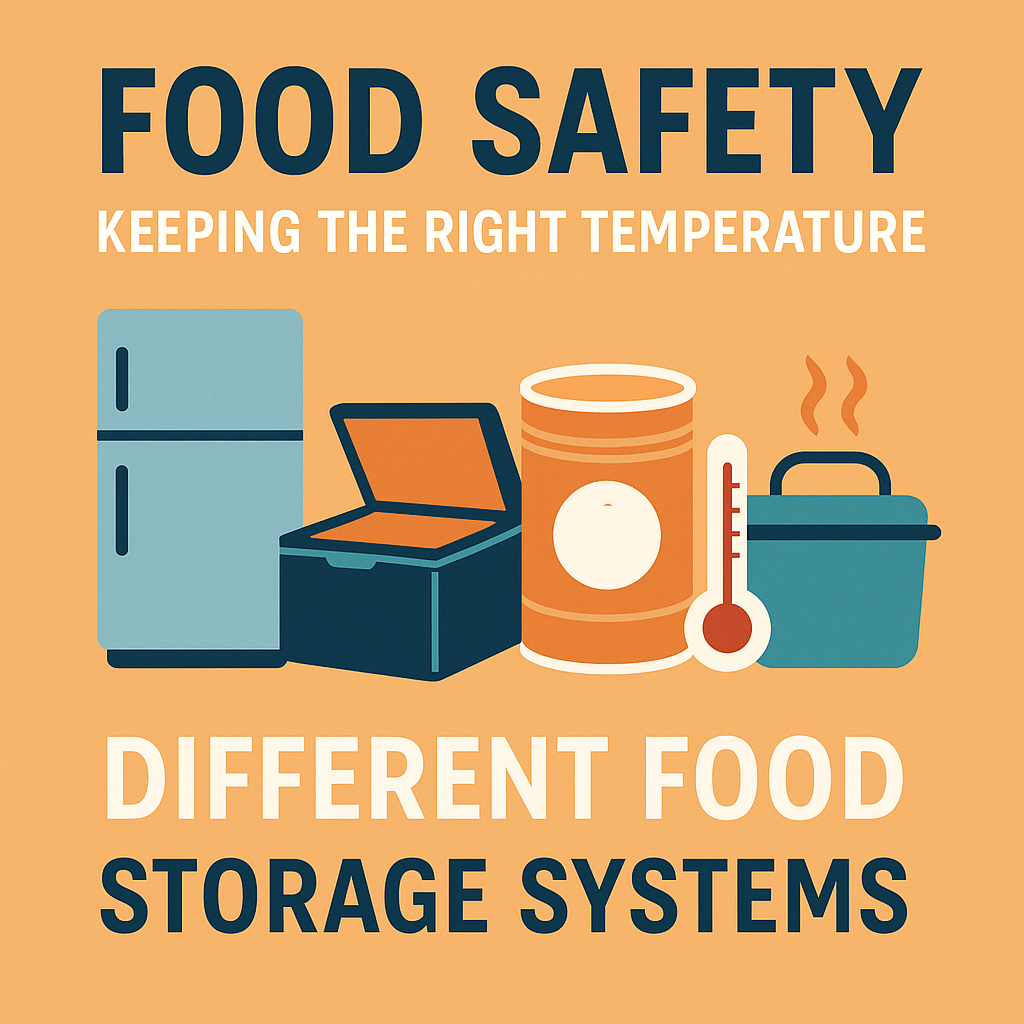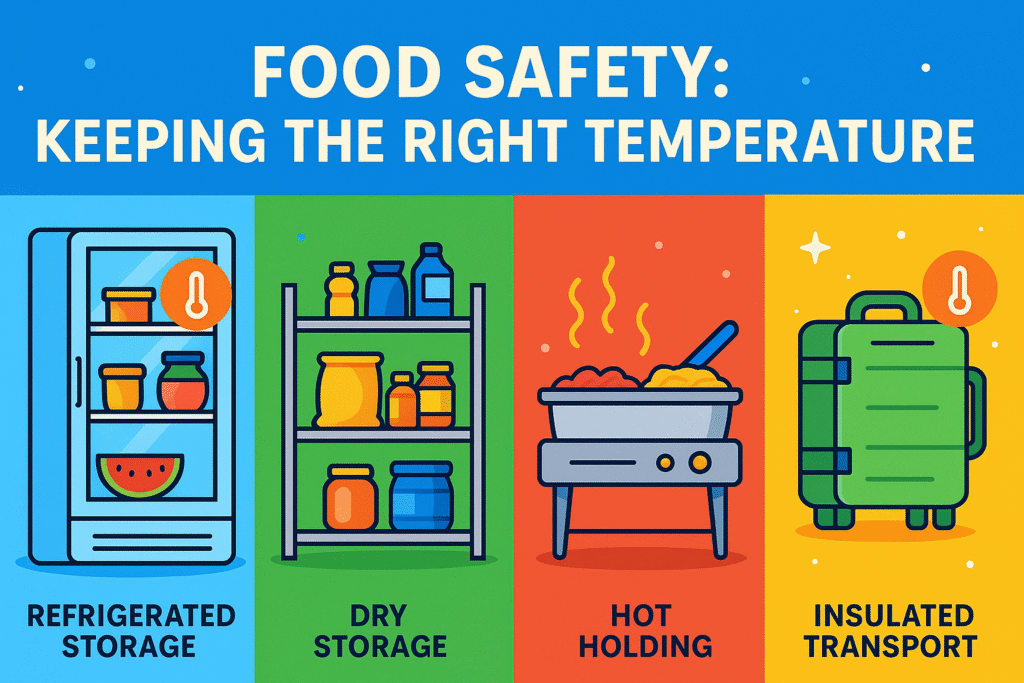Food safety temperature is one of the most critical factors in preventing foodborne illnesses. Whether you’re running a commercial kitchen, food truck, daycare, or health facility, maintaining proper temperature in storage is key.
A lapse in temperature control can cause dangerous bacterial growth, leading to contamination and health risks.

This article dives deep into how different types of food storage systems help maintain safe food temperatures, the importance of thermal regulation, and how to manage cold and hot storage effectively.
Why Food Safety Temperature Matters

Keeping food out of the “danger zone” (between 4°C and 60°C or 40°F and 140°F) is the cornerstone of food safety. In this range, bacteria like Salmonella, E. coli, and Listeria can grow rapidly.
- Cold foods must be kept at or below 4°C (40°F).
- Hot foods must be held at or above 60°C (140°F).
- Foods left between these temperatures for more than two hours may be unsafe to eat.
Temperature abuse is one of the top contributors to food poisoning cases worldwide. According to the World Health Organization (DoFollow), over 600 million people fall ill each year due to contaminated food.
Types of Food Storage Systems
Food storage isn’t just about containers—it’s about the right temperature control systems. Here’s a breakdown of different food storage solutions and how they contribute to food safety temperature compliance.
1. Refrigerated Storage Units (Cold Storage)
These include walk-in coolers, display fridges, and household refrigerators. They are essential for keeping perishable foods like dairy, meats, and vegetables safe.
Key Features:
- Temperature typically maintained at 1°C to 4°C.
- Equipped with thermostats and alarms.
- Ideal for short-term and long-term cold food storage.
💡 Tip: Avoid overcrowding shelves—cold air must circulate freely.
2. Freezer Storage
Freezers preserve food at temperatures below -18°C (0°F), effectively halting microbial activity.

Types:
- Chest Freezers
- Upright Freezers
- Walk-In Freezers
Foods like frozen meat, seafood, and ready-to-cook items must stay frozen solid. Refer to Canada Food Inspection Agency (CFIA) for freezing guidelines. (DoFollow)
3. Dry Storage
Dry storage rooms keep non-perishables like rice, pasta, and canned goods safe from spoilage. Though not cold, they still require temperature control, ideally below 21°C (70°F) with low humidity.
Best Practices:
- Use shelving to prevent moisture contact.
- Store away from heat sources.
- Ensure pest-proof sealing.
🔗 Internal tip: Learn more about proper waste segregation to avoid cross-contamination in dry storage areas. (link to your article on proper waste segregation)
4. Hot Holding Units
Devices like steam tables, hot boxes, and bain-maries maintain cooked food at serving temperatures above 60°C (140°F).
Used In:
- Buffets
- Catered Events
- Cafeterias
Thermal Safety Tip: Always preheat units before placing hot food in them.
5. Insulated Transport Containers
Used for food delivery and off-site catering, these mobile containers maintain hot or cold temperatures during transport.
Technology Includes:
- Insulated foam
- Electric heating or chilling units
- Temperature sensors and GPS tracking
Proper insulation is crucial, especially during long distances or weather extremes.
Temperature Monitoring and Thermometers
You can’t manage what you don’t measure. That’s why thermometers and temperature logs are legally required in many food industries.

Types of Thermometers:
- Infrared: Non-contact, quick readings.
- Probe: Accurate internal temperature of food.
- Digital Data Loggers: Real-time tracking with alerts.
📋 Log It: Regular checks should be documented at least every 2 hours during operations. Many companies use digital logbooks or food safety software for traceability.
Common Food Safety Temperature Mistakes
Avoid these common temperature-related food safety errors:
- Leaving food out to cool before refrigeration.
- Using broken fridge thermometers.
- Storing hot foods in cold storage (they raise the ambient temp).
- Not rotating stock (FIFO—first in, first out rule).
- Repeated freezing and thawing.
Internal cross-reference: These practices align with safe use of industrial kitchen equipment protocols. (link to related article)
Regulatory Guidelines and Standards
Agencies like Health Canada, FDA, and CFIA set strict regulations for food storage temperatures in retail and institutional settings. Failure to comply can lead to legal penalties, business closure, and public health risks.
📌 Key Canadian Standard: CFIA’s Food Retail and Food Services Code requires food handlers to monitor and log food temperature regularly.

Best Practices to Ensure Food Safety Temperature Compliance
- Train Staff: Educate employees on the danger zone and how to monitor food temperatures correctly.
- Label Everything: Include time-stamped labels for ready-to-eat or perishable food.
- Preventive Maintenance: Regularly service cooling and heating equipment.
- Emergency Plans: Know what to do during a power outage—limit fridge opening and use backup generators.
- Conduct Internal Audits: Monthly food safety audits help identify temperature issues before they cause harm.
Final Thoughts on Food Safety Temperature
Food safety temperature isn’t just a number—it’s a responsibility. Whether it’s in a commercial kitchen, grocery store, or healthcare setting, every food handler plays a role in preventing foodborne illnesses through proper temperature control.
Understanding and investing in the right food storage systems—from fridges to hot boxes—makes all the difference.
For more health and safety tips, visit OHSE.ca—your Canadian source for workplace safety knowledge.

No comments yet